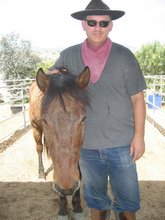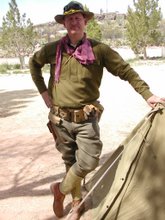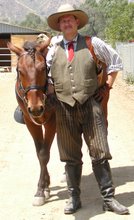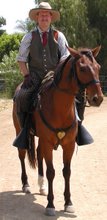
Here's an interesting painting commissioned by the US Army as part of a series depicting the Army throughout its history. This one is from the China relief Expeidtion (aka The Boxer Rebellion). According to the Army:
By early August most of the allied relief force was committed from Tientsin to relieve the Peking legations, leaving behind, among others, the 6th Cavalry and also some men of the British 1st Bengal Lancers. The troops remaining in Tientsin were to secure the lines of communication and obtain information on Boxer or Chinese Imperial troops in the vicinity. Troop A, 6th Cavalry, under 1st Lt. E. R. Heiberg, "armed with carbines and pistols" was ordered to join a detachment of the 1st Bengal Lancers under Lt. J. R. Gaussen on 15 August for a reconnaissance. The allies were to locate, but not engage, a force of Chinese Imperial troops reported west of Tientsin.
The next morning the combined group left early and, after an uneventful ride of about eight miles, seeing nothing but "undestroyed villages, cornfields, and plowed fields," they came across a village flying red flags, usually a sign of enemy troops. Led by Heiberg and Gaussen, the group moved at a trot in a line of skirmishers with a reserve towards the village. Heiberg then saw what seemed to be two rows of trenches, dismounted carefully to scan them, but again nothing unusual could be seen. The force then advanced to within two hundred yards of the trenches when it came under fire from the front and the right and left flanks. In the confusion the skirmishers retired on the reserve and one of them, Cpl. Rasmus Rasmussen, was thrown from his horse at the point of farthest advance. Heiberg and Gaussen saw Rasmussen lying on the ground near the Chinese trenches. Heiberg's horse became unmanageable, so Gaussen rode on. The Chinese, who had also seen Rasmussen, emerged from their trenches to take him prisoner. The race was on. Lieutenant Gaussen reached Rasmussen first. In Heiberg's words, "Lieutenant Gaussen succeeded in mounting Corporal Rasmussen behind him and rode to the rear. But for the gallant lieutenant, I am quite sure that Rasmussen would have been captured, as he was perhaps less than 250 yards from the trenches, and the enemy had left their trenches after him."
The allied contingent fired dismounted for a short time and then withdrew. They returned home at about 1:00 p.m. "without the loss of a single man or horse." For his bravery during the operations in China, Lieutenant, later Brigadier General, J. R. Gaussen was awarded the China medal with clasp and named Companion of the distinguished Service Order.
The painting shows the moment of Corporal Rasmussen's rescue by Lieutenant Gaussen. Both men are in the khaki uniforms preferred for the relief expedition.
The next morning the combined group left early and, after an uneventful ride of about eight miles, seeing nothing but "undestroyed villages, cornfields, and plowed fields," they came across a village flying red flags, usually a sign of enemy troops. Led by Heiberg and Gaussen, the group moved at a trot in a line of skirmishers with a reserve towards the village. Heiberg then saw what seemed to be two rows of trenches, dismounted carefully to scan them, but again nothing unusual could be seen. The force then advanced to within two hundred yards of the trenches when it came under fire from the front and the right and left flanks. In the confusion the skirmishers retired on the reserve and one of them, Cpl. Rasmus Rasmussen, was thrown from his horse at the point of farthest advance. Heiberg and Gaussen saw Rasmussen lying on the ground near the Chinese trenches. Heiberg's horse became unmanageable, so Gaussen rode on. The Chinese, who had also seen Rasmussen, emerged from their trenches to take him prisoner. The race was on. Lieutenant Gaussen reached Rasmussen first. In Heiberg's words, "Lieutenant Gaussen succeeded in mounting Corporal Rasmussen behind him and rode to the rear. But for the gallant lieutenant, I am quite sure that Rasmussen would have been captured, as he was perhaps less than 250 yards from the trenches, and the enemy had left their trenches after him."
The allied contingent fired dismounted for a short time and then withdrew. They returned home at about 1:00 p.m. "without the loss of a single man or horse." For his bravery during the operations in China, Lieutenant, later Brigadier General, J. R. Gaussen was awarded the China medal with clasp and named Companion of the distinguished Service Order.
The painting shows the moment of Corporal Rasmussen's rescue by Lieutenant Gaussen. Both men are in the khaki uniforms preferred for the relief expedition.










No comments:
Post a Comment